Microlife BP3MW1-4B Upper Arm Automatic Digital Blood Presure Monitor User Manual MLU3AC1 JAN05 2
Microlife Corporation Upper Arm Automatic Digital Blood Presure Monitor MLU3AC1 JAN05 2
User manual
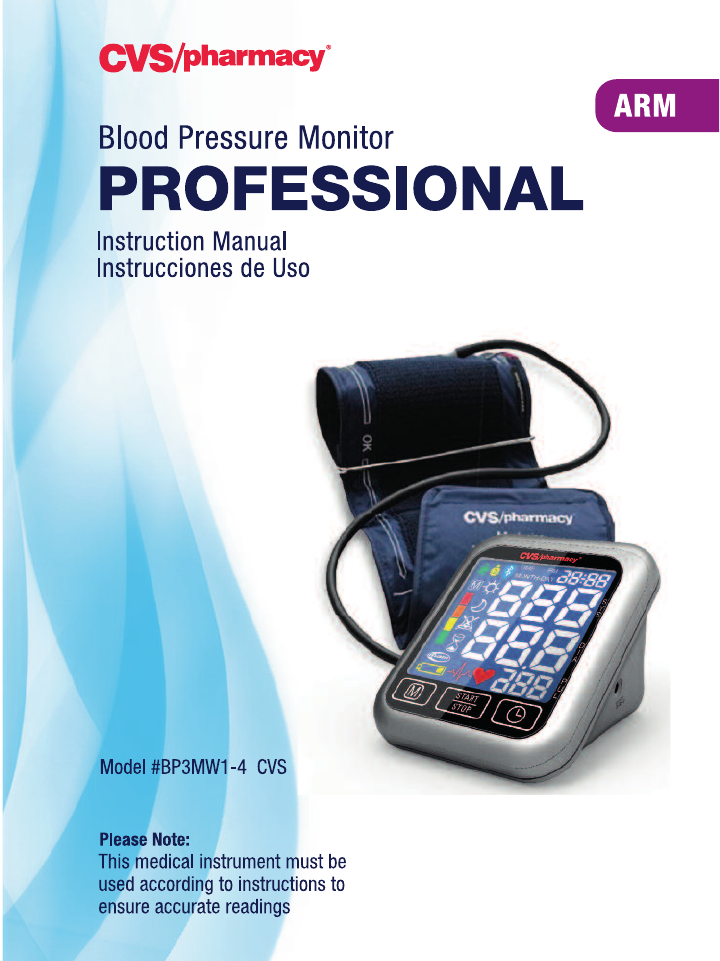
B

Professional Blood Pressure Monitor
Instruction Manual
Table of contents
1. Introduction
1.1. Features of your professional automatic blood pressure monitor
1.2. Important information about self-measurement
2. Important information on blood pressure and its measurement
2.1. How does high/low blood pressure arise?
2.2. Which values are normal?
2.3. What can be done if regular high/low values are obtained?
3. Components of your blood pressure monitor
4. Using your blood pressure monitor for the first time
4.1. Inserting the batteries
4.2. Using the touch pad
4.3. Setting the date and time
4.4. Using the AC power adapter
4.5. Cuff tube connection
4.6. Select the user
4.7. Select the measuring mode: standard or measurement averaging mode
4.8. Measurement averaging mode technology
5. Measurement procedure
5.1. Before measurement
5.2. Common sources of error
5.3. Fitting the cuff
5.4. Measuring procedure
5.5. Memory – displaying the last 120 measurements
5.6 Morning / Evening Hypertension Average
5.7. Discontinuing a measurement
5.8. Setting the medication reminder
5.9. Hypertension risk indicator
5.10. Irregular heartbeat detector
5.11. Battery charge indicator
6. Software functions
6.1. Installation and data transmission
7. CVS Application
1

2
8. Error messages / troubleshooting
9.Care and maintenance
10.Warranty
11. Certifications
12. Technical specifications
13. How to contact us

3
1. Introduction
1.1. Features of your Professional Blood Pressure Monitor
Your blood pressure monitor is a fully automatic digital blood pressure measuring
device for use by adults on the upper arm at home or in your doctor’s/nurse’s office. It
enables very fast and reliable measurement of the systolic and diastolic blood pressure
as well as the pulse by way of the oscillometric method. This device offers clinically
proven accuracy and has been designed to be user friendly.
Up to 20% of women develop hypertension during pregnancy. This disease (preeclamp-
siaor toxemia) affects the final outcome of about 5% of all pregnancies. Preeclampsia
is a disorder that occurs only during pregnancy. It can be recognized by a cleari
ncrease in blood pressure and high protein levels in the urine. The measurement
precision of this device has been proven clinically in a comprehensive study carried out
by Professor Andrew Shennan at St. Thomas’ Hospital, London. This study proved the
reading reliability of this monitor during pregnancy and in the presence of preeclamp-
sia, making it the first such home-use monitor that is clinically validated for such use
and especially suitable for preganant women. Of course, this device can be used also
after the pregnancy or by other family members.
The memory data can be transferred to the PC (personal computer) running the
Microlife Blood Pressure Analyzer (BPA) software by connecting the monitor via cable.
The device can also be used in connection with smart mobile devices running the APP
and via Bluetooth.
Before using, please read this instruction manual carefully and then keep it in a safe
place. Please contact your doctor for further questions on the subject of blood pressure
and its measurement.
Attention!
1.2. Important information about self-measurement
• Self-measurement means control, not diagnosis or treatment. Unusual values must
always be discussed with your doctor. Under no circumstances should you alter the

4
dosages of any drugs prescribed by your doctor.
• The pulse display is not suitable for checking the frequency of heart pacemakers.
• In cases of irregular heartbeat, measurements made with this instrument should
only be evaluated after consultation with your doctor.
Electromagnetic interference:
The device contains sensitive electronic components. Avoid strong electrical or electro-
magnetic fields in the direct vicinity of the device (e.g., mobile telephones, microwave
ovens). These can lead to temporary impairment of the measuring accuracy.
2. Important information on blood pressure and its measurement
2.1. How does high/low blood pressure arise?
Your level of blood pressure is determined in the circulatory center of the brain and
adjusts to a variety of situations through feedback from the nervous system. To adjust
blood pressure, the strength and frequency of the heart (pulse), as well as the width of
circulatory blood vessels is altered. Blood vessel width is affected by fine muscles in
the blood vessel walls.
Your level of arterial blood pressure changes periodically during heart activity. During
the "blood ejection" (Systole), the value is highest (systolic blood pressure value). At
the end of the heart’s "rest period" (Diastole), pressure is lowest (diastolic blood
pressure value).Blood pressure values must lie within certain normal ranges in order to
prevent particular diseases.
2.2. Which values are normal?
Blood pressure is too high if your diastolic pressure is above 100 mmHg and/or your
systolic blood pressure is over 160 mmHg, while at rest. In this case, please consult
your physician immediately. Long-term values at this level endanger your health due to
continual damage to the blood vessels in your body.
If your systolic blood pressure values are between 140 mmHg and 159 mmHg and/or
the diastolic blood pressure values are between 90 mmHg and 99 mmHg, consult your

5
physician. Regular self-checks are necessary.
If you have blood pressure values that are too low (i.e., systolic values under 105
mmHg and/or diastolic values under 60 mmHg), consult your physician.
Even with normal blood pressure values, a regular self-check with your blood pressure
monitor is recommended. You can detect possible changes in your values early and
react appropriately.
If you are undergoing medical treatment to control your blood pressure, keep a record
of values along with time of day and date. Show these values to your physician. Never
use the results of your measurements to independently alter the drug doses
prescribed by your physician.
Which values are normal?
The following standards for assessing high blood pressure (in adults) have been
established by the National Institutes of Health JNC7, 2003.
☞Further information
• If your values are mostly normal under resting conditions but exceptionally high
under conditions of physical or psychological stress, it is possible that you are
suffering from so-called "labile hypertension." Consult your doctor.
• Correctly measured diastolic blood pressure values above 120 mmHg require
immediate medical treatment.
This device is not intended for use on children 12 years of age or younger.
2.3. What can be done if regular high or low values are obtained?
Category Systolic Diastolic
(mmHg) (mmHg)
Normal <120 and <80
Pre-Hypertension 120-139 or 80-89
Hypertension
Stage 1 Hypertension 140-159 or 90-99
Stage 2 Hypertension ≥160 or ≥100

6
a) Consult your doctor.
b) Increased blood pressure values (various forms of hypertension) are associated with
considerable health risks over time. Arterial blood vessels in your body are
endangered due to constriction caused by deposits in the vessel walls (arteriosclero-
sis). A deficient supply of blood to important organs (heart, brain, muscles) can result
from arteriosclerosis. Furthermore, the heart will become structurally damaged with
increased blood pressure values.
c) There are many different causes of high blood pressure. We differentiate between
the common primary (essential) hypertension and secondary hypertension. The latter
group can be ascribed to specific organ malfunctions. Please consult your doctor for
information about the possible origins of your own increased blood pressure values.
d) There are measures which you can take to reduce and even prevent high blood
pressure. These measures must be permane nt lifestyle changes.
1) Eating habits
• Strive for a normal weight corresponding to your age. See your doctor for your ideal weight.
• Avoid excessive consumption of common salt.
• Avoid fatty foods.
2) Previous illnesses
• Consistently follow all medical instructions for treating illness such as:
• Diabetes (diabetes mellitus)
• Fat metabolism disorder
• Gout
3) Habits
• Give up smoking completely.
• Drink only moderate amounts of alcohol.
• Restrict your caffeine consumption (e.g., coffee).
4) Physical constitution
• After a preliminary medical examination, do regular exercise.
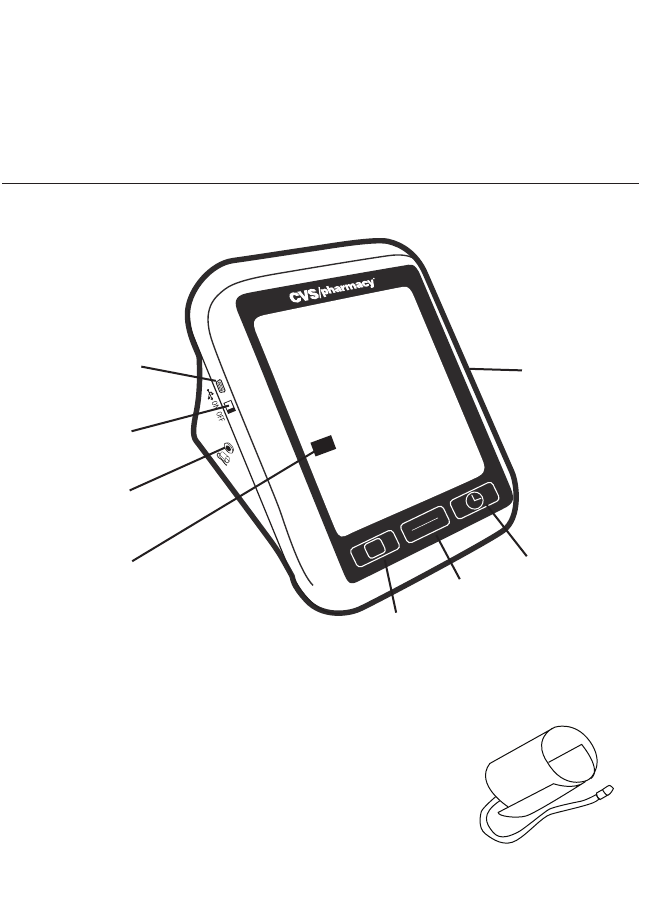
7
• Choose sports which require stamina and avoid those which require strength.
• Avoid reaching the limit of your performance.
• With previous illnesses and/or an age of over 40 years, please consult your doctor
before beginning your exercise routine. You must receive advice regarding the type
and extent of exercise that is appropriate for you.
3. Components of your blood pressure monitor
a) Measuring unit
b) Wide Range Soft Cuff:
For arm circumference 22 cm - 42 cm (8.7” - 16.5”)
If you ever need to buy a replacement cuff, call
CVS/pharmacy®Blood Pressure Support toll-free at
1-866-464-6184.
START
STOP
M
Cuff Socket
Time/Date
Button
ON/OFF/
START/STOP
Mode Switch
Select ON or OFF
Measurements
USB Port
Memory
Recall Button
AC Adapter
Hypertension
Risk Indicator
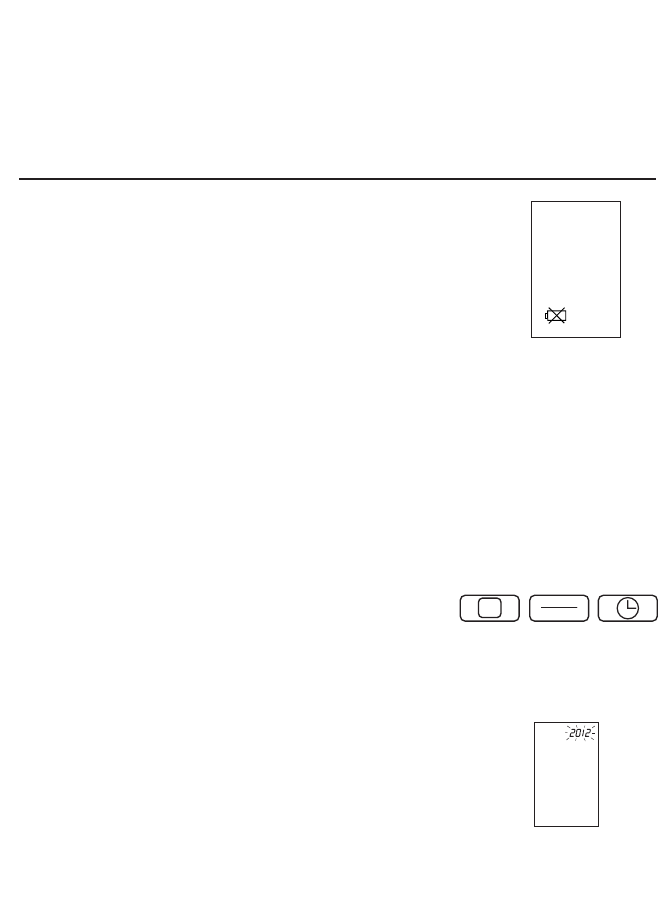
8
Please Note:
Arm circumference should be measured with a measuring tape in the middle of the
relaxed upper arm. Do not force cuff connection into the opening. Make sure the cuff
connection is not pushed into the AC adapter port. If the cuff is too small, call
1-866-464-6184 for further information.
4. Using your blood pressure monitor for the first time
4.1. Inserting the batteries
After you have unpacked your device, insert the batteries.
The battery compartment is located on the bottom of the
device.
a) Remove the battery cover.
b) Insert the batteries (4 x size AA 1.5 V), observing the
indicated polarity.
c) If a battery warning appears in the display, the batteries
are discharged and must be replaced.
Attention!
• After the low battery indicator appears, the device won’t
function until the batteries have been replaced.
• Please use "AA" Long-Life or Alkaline 1.5 V batteries.
• If the blood pressure monitor is not used for long
periods, remove the batteries from the device.
4.2. Using the touch pad
This monitor features three touch pad "buttons" which
operate similarly to traditional buttons, but require only a
light touch of the finger to operate.
• The buttons are MEMORY, START/STOP, and TIME.
Low Battery Indicator
START
STOP
M

9
4.3. Setting the date and time
1. After the new batteries are activated, the year number
flashes in the display. You can advance the year by
pressing the "M" button. To confirm and then set the
month, press the TIME button.
2. You can now set the month using the "M" button. To
confirm and then set the day, press the TIME button.
3. Please follow the instructions above to set the day, hour
and minutes.
4. Once you have set the last minute and pressed the TIME
button, the date and time are set and the time is
displayed.
5. If you want to change the date and time, press and hold
the TIME button down for approximately 3 seconds until
the year number starts to flash. Now you can enter the
new values as described above.
4.4. Using the AC power adapter
You may also operate this monitor using the included AC
adapter.
Use only the included AC adapter to avoid
damaging the unit.
a) Ensure that the AC adapter and cable are not damaged.
b) Plug the adapter cable into the AC adapter port on the
right side of monitor.
c) Plug the AC adapter into a 110 V power socket (U.S. or
Canada).
d) Test that power is available by pressing the START/STOP
button.
Note:
START
STOP
M
Memory
Time/Date
Button
TIME PM
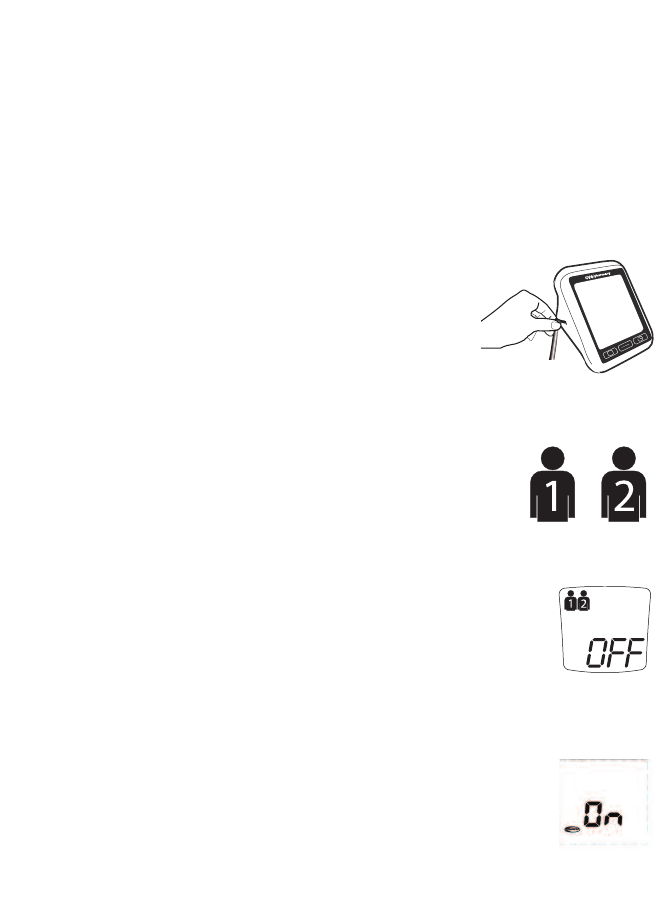
10
• No power is taken from the batteries while the AC
adapter is connected to the instrument.
• If the power is interrupted during a measurement (e.g., by
removal of the adapter from the wall socket), the instru-
ment must be reset by removing the plug from the instru-
ment.
If you have any questions regarding the AC adapter, call
CVS/pharmacy®Blood Pressure Support at 1-866-464-6184.
4.5. Cuff tube connection
Insert the cuff tube into the opening on the left side of the
instrument.
4.6. Select the user
This blood pressure monitor is designed to store 120
measurements for each of two users. In addition, there is a
guest mode in which results are not stored.
Before taking a measurement, be certain that the
correct user has been selected.
a) With the unit off, press and release the TIME button to
cycle through users ("1,""2" or “OFF” (guest mode)).
b) Press the START/STOP button to make your selection.
4.7. Select the measuring mode:
standard or measurement averaging mode (MAM)
This instrument enables you to select either standard (single
measurement) or measurement averaging mode (automatic
triple measurement).
With the unit off, press the Time button for 3 seconds and
then the screen will show the current MAM mode. You can
START
STOP
M
Guest Mode

11
click M button to switch between Standard mode and
Average mode.
To select Standard mode, please choose OFF
To select Average mode, please choose On
If you select OFF, then only one measurement will be taken. If
you select ON, the unit will inflate and deflate three times
resulting in one final average.
4.8. Measurement averaging mode technology (MAM)
• In Measurement Averaging Mode (MAM), three measurements are automatically
taken in succession and the result is then automatically analyzed and displayed.
Because your blood pressure constantly fluctuates, a result determined in this way is
more reliable than one produced by a single measurement.
• After pressing the START/STOP button the selected Measurement Averaging Mode
appears in the display as the MAM symbol.
• The bottom, right-hand section of the display shows a 1, 2 or 3 to indicate which of
the 3 measurements is currently being taken.
5. Measurement procedure
Please note: You should always be seated before and during measurement.
5.1. Before measurement:
•
Avoid eating and smoking as well as all forms of exertion directly before measure-
ment. These factors influence the measurement result. Find time to relax by sitting in
an armchair in a quiet atmosphere for about ten minutes before your measurement.
• Remove any garment that fits closely to your upper arm.
• Always measure on the same arm (normally left).
• Compare measurements at the same time of day, since blood pressure changes
during the course of the day (as much as 20–40 mmHg).
5.2. Common sources of error

12
Note: Comparable blood pressure measurements always require the same
conditions. Conditions should always be quiet.
• All efforts by the user to support the arm can increase blood pressure. Make sure
you are in a comfortable, relaxed position and do not flex any of the muscles in the
measurement arm during the measurement. Use a cushion for support if necessary.
• If the arm artery lies considerably lower or higher than the heart, an erroneously
high or low blood pressure will be measured. Each 15 cm (6”) difference in height
between your heart and the cuff results in a measurement error of 10 mmHg.
• Cuffs that are too narrow or too short result in false measurement values. Selecting
the correct cuff is extremely important. Cuff size is dependent upon the circumfer-
ence of the arm (measured in the center). The permissible range is printed on the
cuff. If this is not suitable for your use, please call 1-866-464-6184.
• A loose cuff or a sideways protruding air pocket causes false measurement values.
• With repeated measurements, blood accumulates in the arm, which can lead to
false results. Consecutive blood pressure measurements should be repeated after a
1 minute pause or after your arm has been held up in order to allow the accumulat-
ed blood to flow away.
5.3. Fitting the cuff
a) The cuff is wide rang and soft for easier use. Please
remove tight or bulky clothing from your upper arm.
b) Wrap the cuff around your upper left arm. The rubber tube
should be on the inside of your arm extending downward
to your hand. Make certain the cuff lies approximately
1/2” to 3/4” (1 to 2 cm) above the elbow.
IMPORTANT: The red strip on the edge of the cuff
(Artery Mark) must lie over the artery which runs down
the inner side of the arm.
TIP: Align red artery mark to pinky finger.
c) To secure the cuff, wrap it around your arm and press the
½”-¾”
8.7” - 18.1”
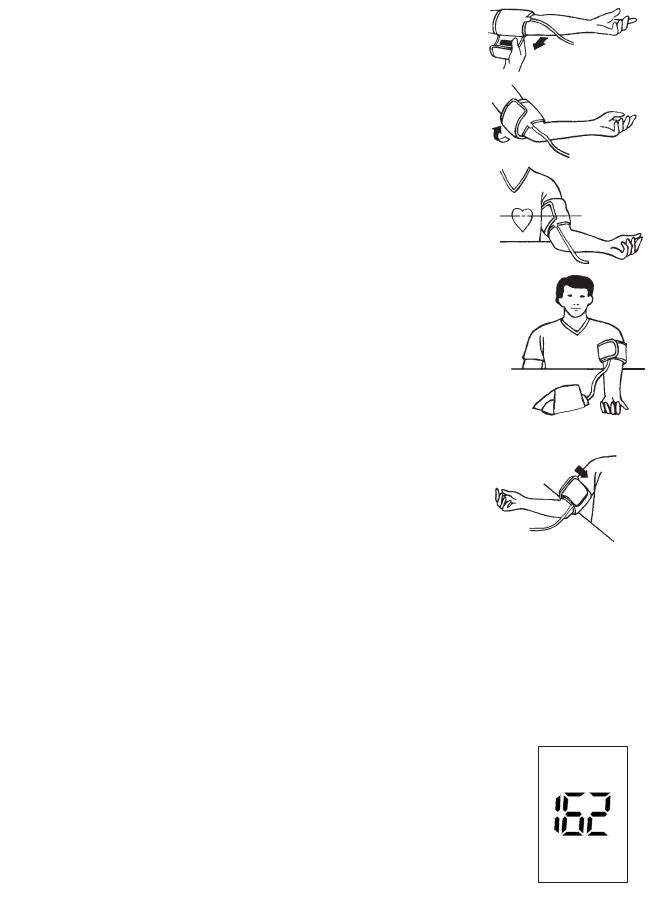
13
hook and loop material together.
d) There should be little free space between the arm and the
cuff. You should be able to fit 2 fingers between your arm
and the cuff. Clothing must not restrict the arm. Any piece
of clothing which does must be removed. Cuffs that don’t
fit properly result in false measurement values. Measure
your arm circumference if you are not sure of proper fit.
e) Lay your arm on a table so the cuff is at the same height
as your heart. Make sure the tube is not kinked.
f) Remain seated quietly for two minutes before you begin
the measurement.
Comment
If it is not possible to fit the cuff to your left arm, it can also
be placed on your right arm. However, all measurements
should be made using the same arm.
Comparable blood pressure measurements always require the
same conditions (relax for several minutes before a reading).
5.4. Measuring procedure
After the cuff has been appropriately positioned the
measurement can begin:
a) Press the START/STOP button. After a series of short
beeps, the pump begins to inflate the cuff. On the display,
the increasing cuff pressure is continually shown.
b) After automatically reaching an individual pressure, the
pump stops and the pressure slowly falls. The cuff
pressure is displayed during the measurement.
Cuff on
right arm
Pumping
Pressure
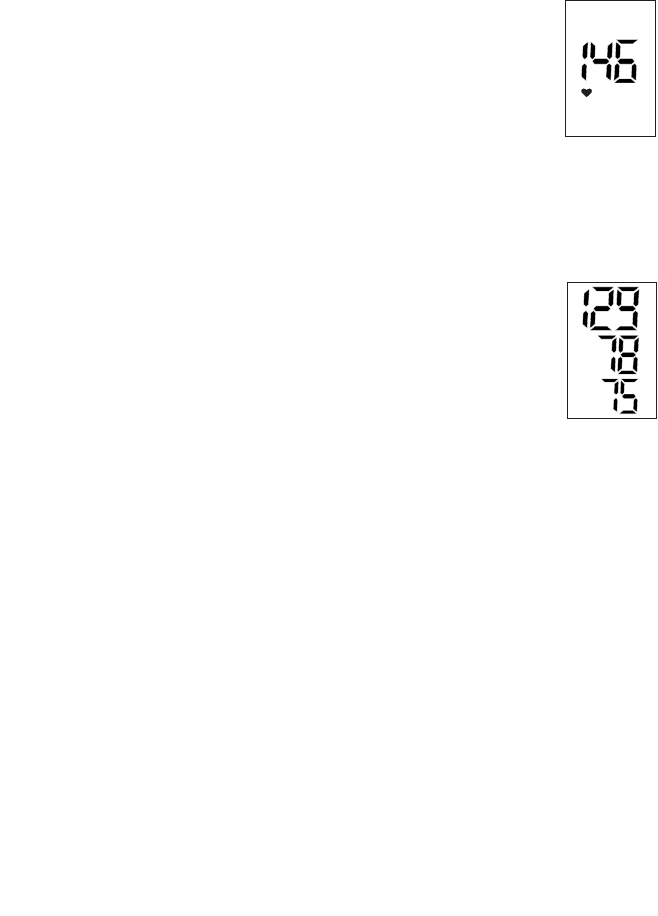
14
c) When the device has detected your pulse, the heart
symbol in the display begins to blink.
d) When the measurement has been concluded, the air will
automatically release from the cuff. The measured systolic
and diastolic blood pressure values, as well as the pulse,
are now displayed.
e) The measurement results are displayed until you switch
the device off. If no button is pressed for 1 minute, the
device switches off automatically.
f) When the unit is set to the MAM (Measurement Averaging
Mode) setting, 3 separate measurements will take place in
succession, after which your result is calculated and
displayed as a single, averaged measurement. There is a 15
second resting time between each measurement. A count-
down indicates the remaining time and a beep will sound
for 5 seconds before the 2nd and 3rd readings begin.
If one of the measurements causes an error message, it will
be repeated one more time. If any additional error occurs, the
measurement will be discontinued and error code displayed.
Expanding the averaged measurement to see the three
individual readings:
This function allows you to view the three individual
measurements used to calculate the Measurement
Averaging Mode (MAM) reading.
a) After taking an averaging mode measurement, hold the memory button for 3 seconds
until you hear a short beep. (Do not hold the button longer than 7 seconds or you
will delete all the readings in the memory.)
b) Release the button and watch the screen. It will automatically scroll through the 3
measurements used in the reading.
Measurement
Complete
Systolic
Diastolic
Pulse
Measuring

15
5.5. Memory – displaying the last 120 measurements
At the end of a measurement, this monitor automatically stores each result with date
and time. This unit stores 120 memories for each of 2 users.
Viewing the stored values
With the unit off, press the "M" button. The display first shows "A," then shows an
average of all measurements stored in the unit. Please note: Measurements for each
user are averaged and stored separately. Be certain that you are viewing the measure-
ments for the correct user.
Pressing the "M" button again displays the previous value. To view a particular stored
memory, press and hold the "M" button to scroll to that stored reading.
Memory full
When the memory has stored 120 results, a new, measured value is stored by
overwriting the oldest value.
Clear all values
If you are sure that you want to permanently remove all stored values,
hold down the "M" button (the instrument must have been switched off
beforehand) until "CL" appears and then release the button. If you do not
want to clear the values, press the START/STOP button. To permanently
clear the memory, press the "M" button while "CL" is flashing.
Individual values cannot be cleared.
5.6 Morning / Evening Hypertension Average
Morning Hypertension usually occurs as a surge in blood pressure upon waking up, this
Blood Pressure Monitor (BPM) will average readings taken between 4:00 A.M. and
11:50 A.M.. Evening hypertension, sometimes called nocturnal hypertension, is charac-
terized by high blood pressure that persists from night time until early morning; this BP
monitor will average reading taken between 6:00 P.M. and 11:59 P.M..
With the unit off, press the M (Memory) pad to display the average reading for the
1

16
current user.
Press the M pad again, the screen will show the average of all reading taken between
4:00 A.M. and 11:50 P.M. The screen will display the sun icon.
When you press the M (Memory) pad a third time, the screen will show the average of
all readings taken between 6:00 P.M. and 11:59 P.M.. The screen will display the moon
icon.
After 30 seconds, the screen will display the last taken value. You can continuously
press the M (Memory) pad to view each value individually.
5.7.Discontinuing a measurement
If it is necessary to interrupt a blood pressure measurement for any reason (e.g., the
patient feels unwell), the START/STOP button can be pressed at any time. The device
then immediately lowers the cuff pressure automatically and enters sleep mode.
5.8. Setting the medication reminder
This instrument allows you to set two alarm times at which an alarm signal will then
be triggered. This can be a useful aid, for instance as a reminder to
take medication or to remind you to take your blood pressure at the
same time each day.
1. To set an alarm time, press the TIME button (the instrument
must have been switched off beforehand), and immediately
afterwards the "M" button, and hold both down until the bell
symbol appears in the bottom left of the display. Then release
both buttons. The flashing "1" in the display indicates that the
first alarm time can now be set.
2. Press the TIME button to set the hours – the hours display
flashes and pressing the "M" button allows you to set the alarm
hour. To confirm, press the TIME button.
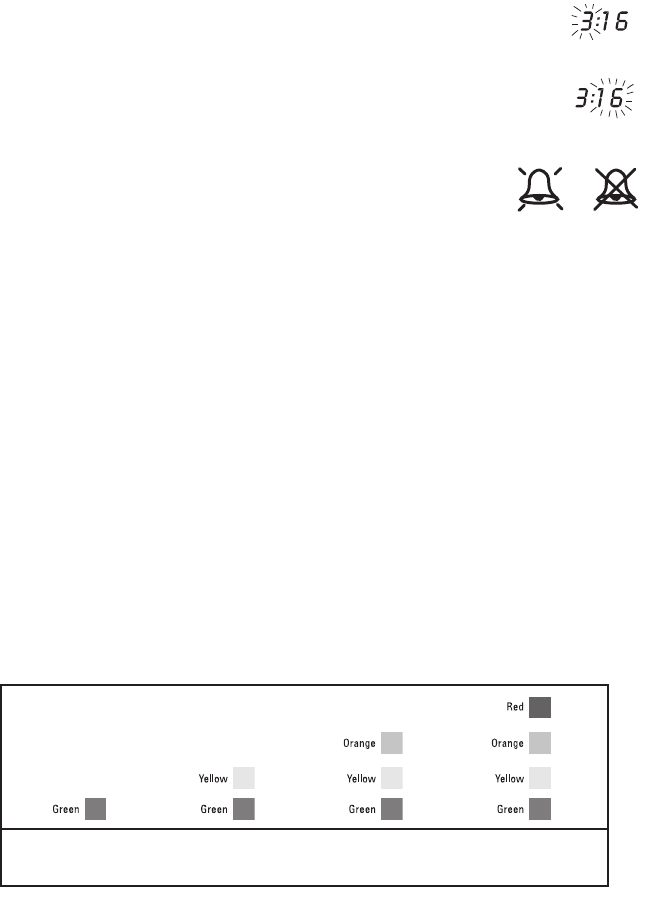
17
3. The minute display will now flash. The minutes can be set using
the "M" button. To confirm, press the TIME button again.
4. The bell symbol will now flash. Use the "M" button to select
whether the alarm time is to be active (bell) or inactive (crossed-
out bell). To confirm, press the TIME button.
To set a second alarm time, proceed as above but if the "1" flashes,
press the "M" button to select "2" and confirm with the TIME
button.
• An active alarm time is indicated by the bell symbol in the display.
• The alarm sounds at the set time every day.
• To switch off the alarm when it is sounding, press the START/STOP button.
• To permanently switch off the alarm, proceed as above (steps 1-4) and select the
crossed-out bell symbol. This will then disappear from the display.
• The alarm times must be re-entered each time the batteries are replaced.
5.9. Hypertension risk indicator
The bars on the left-hand edge of the display show you the range within which the
indicated blood pressure value lies. Depending on the height of the bar, the readout
value is either within the normal (green), borderline (yellow) or danger (orange, red)
range.
The classification is based on standards established by the National Institutes of
Health JNC7, 2003.
Refer to the chart in section 2.2 of this instruction manual for details of the classifications.
Indication of a
"Normal" Blood
Pressure
Indication of a "Pre-
Hypertension" Blood
Pressure
Indication of a "Stage 1
Hypertension" Blood
Pressure
Indication of a "Stage 2
Hypertension" Blood
Pressure
TIME PM
TIME PM
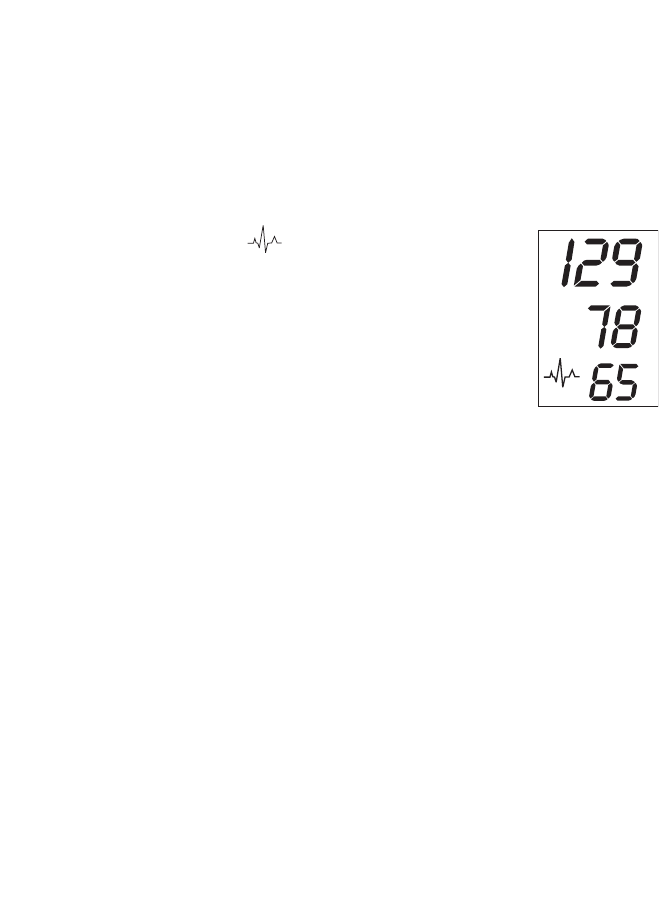
18
The traffic light bar illuminates according to your measurement.
• If your measurement has only the green bar,
your measurement is "Normal," according
to NIH standards.
• If your measurement shows the yellow bar, your measurement is "Pre-Hypertension."
• If your measurement shows the orange bar, it is "Stage 1 Hypertension."
• If your measurement shows the red bar, it is "Stage 2 Hypertension."
5.10.Irregular heartbeat detector
The appearance of this symbol indicates that certain pulse
irregularities were detected during the measurement. In this case,
the result may deviate from your normal basal blood pressure –
repeat the measurement. In most cases, this is no cause for concern.
However, if the symbol appears on a regular basis (e.g., several times
a week with measurements taken daily), we advise you to tell your
doctor.
Please show your doctor the following explanation:
Information on frequent appearance of the irregular heartbeat symbol
This instrument is an oscillometric blood pressure monitor device that also analyzes
pulse frequency during measurement. The instrument is clinically tested.
If pulse irregularities occur during the measurement, the irregular heartbeat symbol is
displayed with the measurement.
If the symbol appears frequently or if it suddenly appears more often than usual, we
recommend the patient seek medical advice. The instrument does not replace a cardiac
examination but serves to detect pulse irregularities at an early stage.
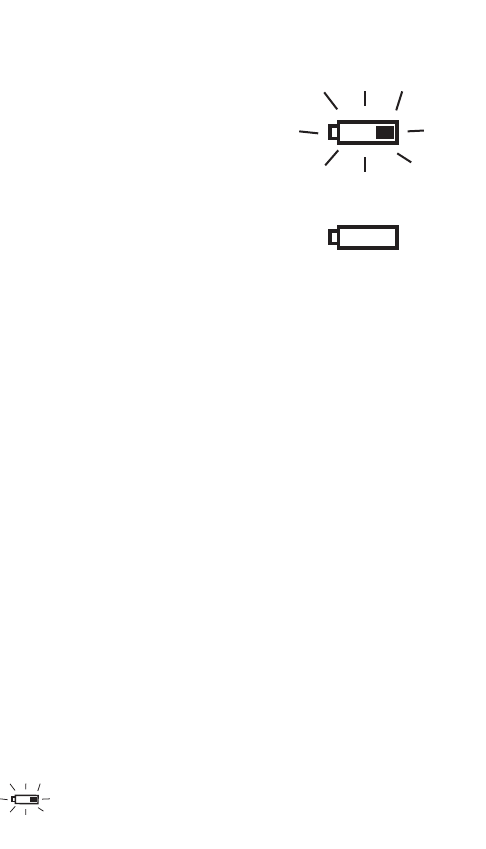
19
5.11. Battery charge indicator
Batteries almost discharged
When the batteries are approximately 75% used, the battery
symbol will flash a few times as soon as the instrument is
switched on (if at least one of the batteries still has some
charge). Although the
instrument will
continue to measure reliably, you should obtain
replacement batteries.
Batteries discharged – replacements required
When the batteries are discharged, the battery symbol will
appear, unblinking, as soon as the instrument is switched on.
You cannot take any further measurements and must replace the
batteries.
1. Open the battery compartment on the bottom of the instrument.
2. Replace the batteries – ensure they are correctly connected, as shown on the
symbols in the compartment.
3. The memory retains all values although date and time (and possibly also set alarm
times) must be reset – the year number will flash automatically after the batteries
are replaced.
4. To set date and time, follow the procedure described in Section 4.3.
Note:
Use four new, Long-Life 1.5 V AA batteries. Do not use batteries beyond their expira-
tion date. If the monitor is not going to be used for a prolonged period, the batteries
should be removed.
Using rechargeable batteries
You can also operate this instrument using rechargeable batteries.
• Please use only type "NiMH" reusable batteries.
• If the battery symbol ( ) appears, the batteries must be removed and
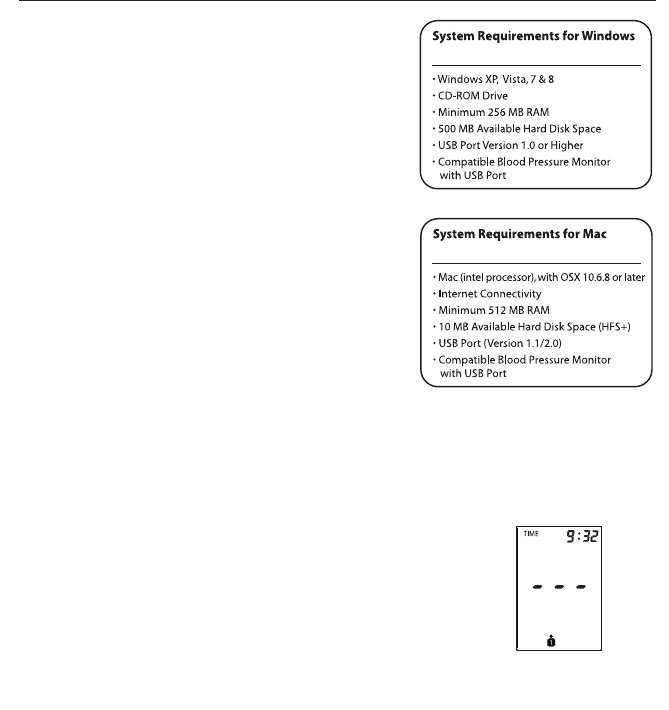
20
recharged. They must not remain inside the instrument, as they may become
damaged through total discharge even when switched off. The batteries must NOT
be discharged in the blood pressure monitor. If you do not intend to use the instru-
ment for a week or more, always remove the rechargeable batteries.
• Recharge these batteries using an external charger and follow manufacturer’s
instructions carefully.
6. Software functions
This unit can be used in connection with your compu-
er (PC / MAC) running the PC Link blood pressure
analyzer software. Your computer will allow a
capacity of monitoring 80 patients, each with 1000
data (note: overuse will lower system efficiency). The
memory
data can be transferred to the computer by connect-
ing the monitor via the included USB cable. User can
get the BPA (Blood Pressure Analyzer) software
either the provided
CD or download the BPA on Microlife web site:
http://www.microlife.com/support/software/
6.1. Installation and data transmission
a) install the BPA software on your PC or MAC
computer, users can choose BPA
revision 3.2.5 or higher revision.
b) Connect the monitor via USB cable with the PC.
Three horizontal bars will appear on the display and
last for 3 seconds.
Blood Pressure Analyzer Rev.: 3.2.5 or higher Blood Pressure Analyzer Rev.: 3.2.5 or higher
Blood Pressure Analyzer Rev.: 3.2.5 or higher

21
c) The bars will then flash to indicate that the connec-
tion between computer and device is successfully
made. As long as the cable is plugged, the bars will
keep flashing and the buttons are disabled.
During the connection, the device is completely
controlled by the computer. Please refer to the "Help"
file in the software for detailed instructions or call
1-866-464-6184.
7. CVS Application
Please download Microlife BPM Application from the App Store or Google Play before
attempting to pair your devices. Microlife BPM Applications can be executed on a
mobile platform, which comply with the required compatibility as the following:
Compatibility:
- Paring your device running iOS 6.0 or higher on iPhone, iPad, and iPod
touch.
- Paring your device running Android 2.3.3 or higher on Android Phone and
Android Tablets
Connection between Blood Pressure Monitor and Mobile Device:
a). Please switch the slide switch to “On” to turn on Bluetooth function on
your device.
Next, press the I/O for 8 sec until the BT icon appears on the screen.
b). The BT icon will flash on the screen for 60 sec for users to pair
devices, if there is
no any operations implemented in 1 min, then the BT function will be
turned off.
c). Turn Bluetooth “On” under the setting Menu on the iOS or Android
device.
d). Open Microlife BPM APP to pare and connect your Blood Pressure
1
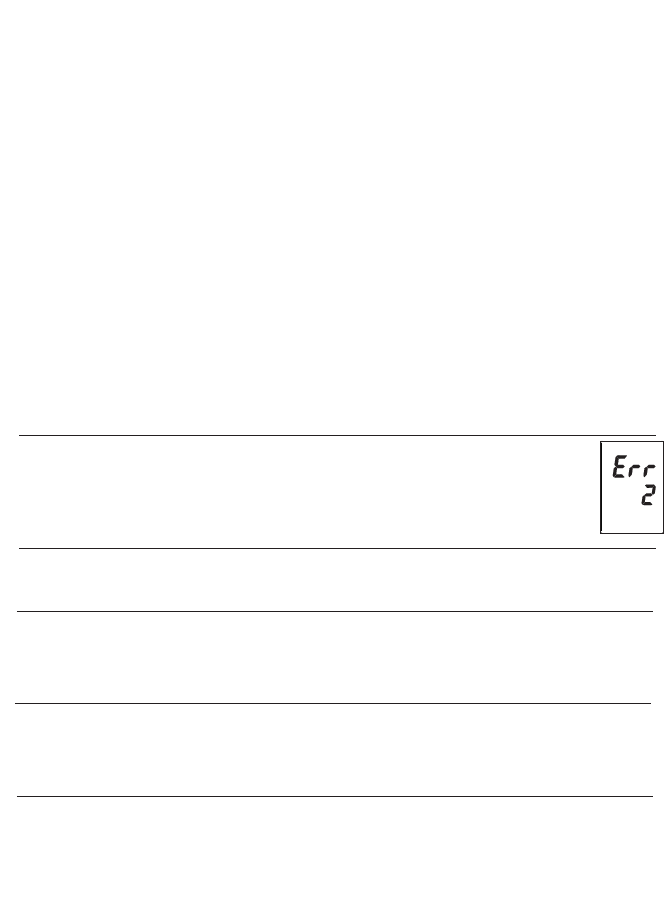
22
Monitor.
Data Transmission:
Please make sure your Blood Pressure Monitor and your iOS / Android
device are in connecting status before you do data transmission
a). Open Microlife BPM APP on your iOS or Android mobile device.
b). When you choose “Download all data”, the App will show a data
transmitting display on the screen as below:
c). After finishing data transmitting, the App will directly enter a
summary page.
Microlife BPM Application can transfer, store and convert formats and
display medical device data on your mobile device without modifying
the data. So, you can record, collect and track your data from a mobile
device to eventually share with others.
8.Error messages/troubleshooting
If an error occurs during a measurement, the measurement is discontinued
and a corresponding error code is displayed (example: Error no. 2).
Error No. Possible cause(s)/Solutions
ERR 1 The tube may have loosened, or no pulse was detected.* Ensure
cuff connections are tight with proper cuff placement. See section 5.3.
ERR 2 Unnatural pressure impulses influenced the measurement result.
Reason: The arm was moved during the measurement (artefact).
Repeat measurement, keeping still and quiet.
ERR 3 Inflation of the cuff takes too long. The cuff is not correctly seated
or the hose connection is not tight. Re-position cuff and repeat the
measurement.
ERR 5 The measured readings indicated an unacceptable difference
between systolic and diastolic pressures. Take another reading
following directions carefully. Contact your doctor if you continue to

23
get unusual readings.
HI The cuff pressure is too high. Relax for 5 minutes and repeat the
measurement.*
LO The
pulse is too low (less than 40). Repeat the measurement.*
*If this or any other problem occurs repeatedly, please consult your doctor.
Other possible errors and their solutions
If problems occur when using the device, the following points should be checked and,
if necessary, the corresponding measures are to be taken:
Malfunction Remedy
1. Check batteries for the correct polarity.
2. If the display is unusual, remove the
batteries and exchange them for new ones.
Check the connection of the cuff tube and
connect properly.
1.Check the positioning of the cuff.
2.Measure blood pressure again in peace
and quiet, carefully following the details
in Section 5.
The display remains blank when the instru-
ment is switched on although the batteries
are in place.
The pressure does not rise although the
pump is running.
The device frequently fails to measure blood
pressure values or the values measured are
too low or high.
Please read the following information and
points listed in Section 5.2 "Common
sources of error." Repeat the measurement
.
Please note: Blood pressure fluctuates
continually so successive measurements
will show some variability.
Record the daily development of the
measured values and consult your doctor.
Please note: Individuals visiting their
doctor frequently experience anxiety
which can result in a higher reading
than at home under resting conditions.
Every measurement results in a different
value, although the device functions
normally and normal values are displayed.
Blood pressure values differ from those
measured by my doctor.
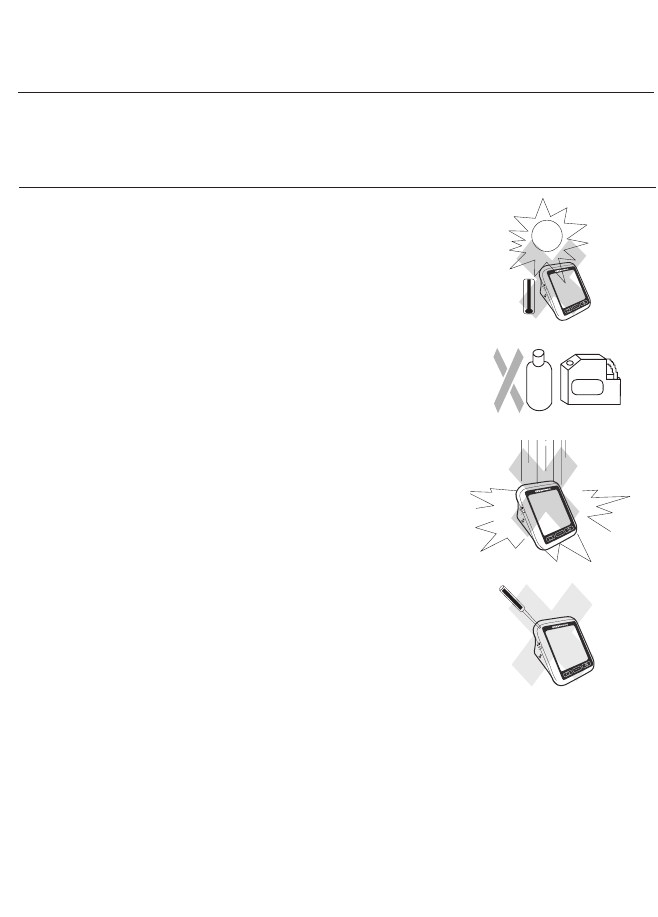
24
9. Care and maintenance
a) Do not expose the device to either extreme temperatures,
humidity, dust or direct sunlight.
b) The cuff contains a sensitive airtight bubble. Handle this
cuff carefully and avoid all types of stress through twisting
or buckling.
c) Clean the device with a soft, dry cloth. Do not use
gasoline, thinners or similar solvents. Spots on the cuff can
be removed carefully with a damp cloth and soapsuds. The
cuff must not be washed in a dishwasher, clothes
washer or submerged in water.
d) Handle the tube carefully. Do not pull on it. Do not allow
the tubing to kink and keep it away from sharp edges.
e) Do not drop the monitor or treat it roughly in any way.
Avoid strong vibrations.
f) Never open the monitor. This invalidates the manufac-
turer’s warranty.
g) Batteries and electronic instruments must be disposed of
in accordance with the locally applicable regulations, not
with domestic waste.
h) Please ensure that children do not use this devices
unsupervised; some prts are small enough to be
swallowed. Be aware of the risk of strangulation in case
this device is supplied with cables or tubes.
Gasoline
START
STOP
M
START
STOP
M
START
STOP
M
1. Check cuff connections.
2.
Ensure the unit has not been tampered with.
After the instrument has inflated the cuff
the pressure falls very slowly, or not at all.
(No reasonable measurement possible.)

25
i) Please do not use the device if you think it is damaged or if
anything appears unusual.
☞ Further information
Blood pressure is subject to fluctuations, even in healthy people.
Comparable measurements always require the same conditions (quiet
conditions)! If fluctuations in readings are larger than 15 mmHg, and/or you
hear irregular pulse tones, consult your doctor.
Never attempt to repair the instrument yourself.
Any unauthorized opening of the instrument invalidates all warranty claims.
10. Warranty
Your Professional Blood Pressure Monitor is guarante for a lifetime against
manufacturer defects for the original purchaser only, from date of purchase. The
warranty does not apply to damage caused by improper handling, accidents, profes-
sional use, not following the operating instructions or alterations made to the instru-
ment by third parties.
Lifetime warranty only applies to the instrument. All accessories including the cuff, AC
adapter and software are guaranteed for one year.
There are no user serviceable parts inside. Batteries or damage from old batteries is
not covered by the warranty.
Please note: According to international standards, your monitor should be checked for
accuracy every 2 years.
11. Certifications
Device standard: Device corresponds to the requirements of
the standard for non-invasive blood
pressure monitors:

26
AAMI/ ANSI/ IEC 80601-2-30
IEC 60601-1
IEC 60601-1-2
IEC 60601-1-11
- Bluetooth system to V4.0
- FCC Part 15C
Electromagnetic compatibility: Device fulfills the stipulations of the
International standard IEC 60601-1-2
Clinical testing: Clinical performance tests were carried
out in the US according to ANSI/AAMI
standard.
The B.H.S. (British Hypertension Society) clinical protocol was used to measure the
accuracy of this product. Blood pressure units using the same measurement technology
are graded "AA" for systolic/diastolic accuracy by independent investigators using the
BHS protocol. This is the highest grading available for blood pressure monitors. Please
see bhsoc.org for more information.

27
12. Technical specifications:
Weight: . . . . . . . . . . . . . . . . . . . . . . . . . . . 468 g (with batteries)
Size: . . . . . . . . . . . . . . . . . . . . . . . . . . . . . .110 (W) x 120 (L) x 85 (H) mm
Storage temperature: . . . . . . . . . . . . . . . . .-20 to +55°C (-4° to +131°F)
Humidity: . . . . . . . . . . . . . . . . . . . . . . . . . . 15 to 90% relative humidity maximum
Operation temperature: . . . . . . . . . . . . . . . 10 to 40°C (50° to 104°F)
Display: . . . . . . . . . . . . . . . . . . . . . .. . . . . .LCD (Liquid Crystal Display)
Measuring method: . . . . . . . . . . . . . . . . . .Oscillometric
Pressure sensor: . . . . . . . . . . . . . . . . . . . . .Capacitive
Measuring range:
SYS/DIA: . . . . . . . . . . . . . . . . . . . . . . . . . . 30 to 280 mmHg
Pulse: . . . . . . . . . . . . . . . . . . . . . . . . . . . . .40 to 200 per minute
Cuff pressure display range: . . . . . . . . . . . .0-299 mmHg
Memory: . . . . . . . . . . . . . . . . . . . . . . . . . .Automatically stores the last 120
measurements for 2 users (total 240)
Measuring resolution: . . . . . . . . . . . . . . . . 1 mmHg
Accuracy: . . . . . . . . . . . . . . . . . . . . . . . . . .Pressure within ± 3 mmHg or 2% of
reading >200 mmHg
Pulse ± 5% of the reading
Power source: . . . . . . . . . . . . . . . . . . . . . . . .a) 4 AA batteries, 1.5 V
b) AC adapter 6 V DC 600 mA
(voltage 4.5 V DC to 6 V DC)
Battery life: . . . . . . . . . . . . . . . . . . . . . . . . .Approximately 500 measurements.
Expected service life: . . . . . . . . . . . . . . . . 5 years

28
Cuff life: . . . . . . . . . . . . . . . . . . . . . . . . . . 2 years
IP Classification . . . . . . . . . . . . . . . . . . . . . .IP20
Accessories: . . . . . . . . . . . . . . . . . . . . . . . . Cuff type: Wide range soft cuff for arm
circumference 22-42 cm (8.7"-16.5")
BP analyzer software CD
USB (A to mini B) cable
Storage case
Technical alterations reserved.
The adapter was made by Dee Van Enterprise Co., Ltd,
Model number is: DSA-6E-05 US 6006010
Made in China
Read the instructions carefully before using this device.
Type BF applied part.
IP20: Protected against solid foreign particles with a diameter of more than
12.5 mm, no protection against water)
Version of user's manual: BP3MW1-4BCVS IB-001
Not for use on children 12 years of age or younger.

29
13. How to contact us
Distributed by: CVS Pharmacy, Inc.
One CVS Drive, Woonsocket, RI 02895
© 2012 CVS/pharmacy
www.cvs.com 1-800-shop-CVS
Toll Free Customer Support Line: 1-866-464-6184
Email: CVSbpsupport@microlifeusa.com

30
Federal Communications Commission (FCC) Statement
15.105(b)
This equipment has been tested and found to comply with the limits for a Class B
digital device, pursuant to part 15 of the FCC rules. These limits are designed to
provide reasonable protection against harmful interference in a residential installation.
This equipment generates, uses and can radiate radio frequency energy and, if not
installed and used in accordance with the instructions, may cause harmful interference
to radio communications. However, there is no guarantee that interference will not
occur in a particular installation. If this equipment does cause harmful interference to
radio or television reception, which can be determined by turning the equipment off
and on, the user is encouraged to try to correct the interference by one or more of the
following measures:
-Reorient or relocate the receiving antenna.
-Increase the separation between the equipment and receiver.
-Connect the equipment into an outlet on a circuit different from that to which the
receiver is connected.
-Consult the dealer or an experienced radio/TV technician for help.
15.21
You are cautioned that changes or modifications not expressly approved by the part
responsible for compliance could void the user’s authority to operate the equipment.
FCC RF Radiation Exposure Statement:
1. This Transmitter must not be co-located or operating in conjunction with any
other antenna or transmitter.
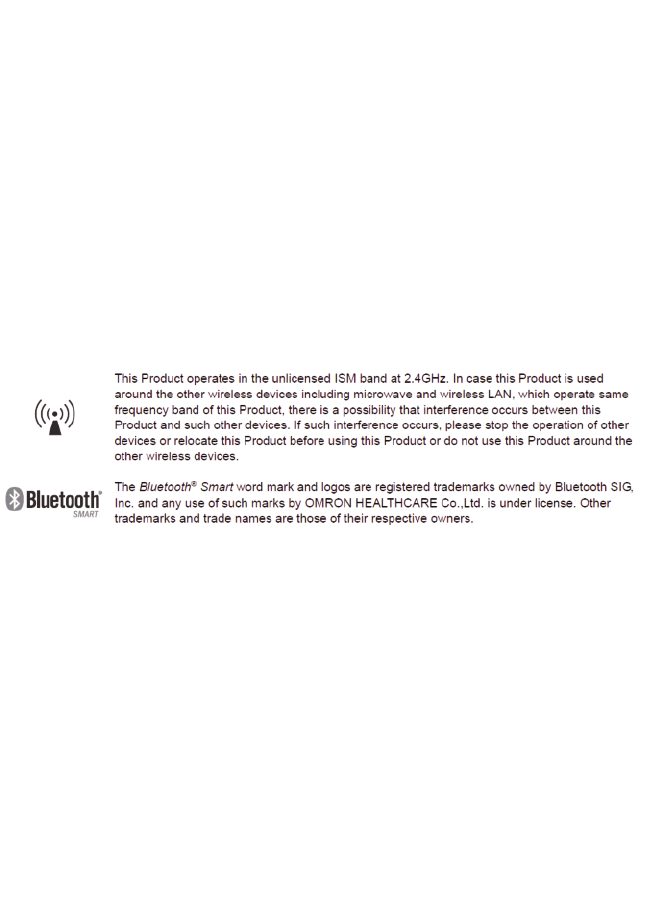
31
2. This equipment complies with FCC RF radiation exposure limits set forth for an
uncontrolled environment. This equipment should be installed and operated with a
minimum distance of 20 centimeters between the radiator and your body.
15.19
This device complies with Part 15 of the FCC Rules.
Operation is subject to the following two conditions:
1) this device may not cause harmful interference and
2) this device must accept any interference received, including interference that may
cause undesired operation of the device.
Statements and Trademarks
Apple, the Apple logo, iPad, and iPhone are trademarks of Apple Inc., registered in the
U.S. and other countries. App Store is a service mark of Apple Inc.
Android and Google Play are both trademarks of Google Inc.
Samsung and Galaxy S are both registered trademarks of Samsung Electronics Co., Ltd.
Sony, Xperia M4 and Nexus 5 are registered trademarks of Sony Co., Ltd.

32
Manufacturer’s declaration – Electro Magnetic Compatibility (EMC)

33
Guidance and manufacturer’s declaration – electromagnetic immunity

34
Guidance and manufacturer’s declaration – electromagnetic immunity

35
Guidance and manufacturer’s declaration –